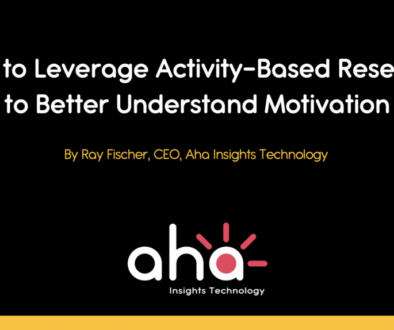5 Tips on How to Design a Strategic Online Qual Study (Video)
Ray Fischer, CEO of Aha!, shares the basics and best practices for online qual consumer research study design to get deeper consumer insights. Watch the video now…
I want to talk to you about how to run a great online study. I’m going to cover the five key elements that I think are relevant to success. let’s start with clear objectives. You’ve got to get buy-in from your client as exactly what it is you want to accomplish with this online study. And with these objectives you need to understand what do you want to do at the end? What do you want to pull out of the study? What are going to be the key findings, what is the mission all about? Then, you want to make sure that you create activities that are very focused, direct. Don’t waste a respondent’s time. You can do a lot of stuff with them, but you don’t want to be redundant, you want to stick to the mission, and you don’t want it to be a free-for-all. When you get to the free-for-all phase, you get too many questions in there, too many open-ends, and it really becomes a survey versus a human interactive, deep dive into their psyche. So, what we recommend you do is that you establish these objectives, build the activities around those, make sure you’ve got a very structured set of time that you’re expecting each respondent to participate in each day of the study. And a pretty good best practice approach is 30-45 minutes, and again the incentives need to match up that kind of work. You want to stay on task as far as what it is you’re trying to learn. Build in some projective activities. Again collaging, journey mapping, storytelling, fill-in-the-blanks, those kinds of things are fun and engaging for respondents to do. And, of course, you’re going to have to throw in some open ends, and occasionally there’s some closed ends that have to be tossed in as well. Again, but keep it focused, structured, and to the point.
One of the most important aspects to running a great online study is keeping the recruiter involved from the beginning to the end. And there’s a lot of different options out there on recruiting. Some of those are price-driven. So, again, the old style, focus group recruiting, is the highest quality, most expensive way to go. And then there’s some quant tools, methods, and different panels that you can use that help to drive some costs down, and maybe can pick up the speed and make things a little bit more efficient. Those aren’t completely proven yet. They are real good, but again, the old style focus group, database recruiting methods, tend to be the most effective.
The other thing that you need to do is you’ve got to make sure that your incentive matches the workload that you’re asking the respondents to do. So, for instance, if you’re asking them to do a three-day study, that’s going to take about 30 minutes per day, you probably want to look at that as somewhere around, you know, $100. A good rule of thumb is to say a dollar per minute of expected time expended against the study. You throw in a store trip, you want to give them a little bit more money, maybe 25-50 more dollars. So, again, incentive needs to match the workload. If you try to go cheap and go on a point system, you’re not going to get the level of connectivity that you will get on a real, straightforward cash payout incentive.
Another important thing is to stick to the schedule. If you tell them it’s three days, make sure it’s three days. Sure, you can probe all you want. If the study’s going to start on the 21st, make sure it starts on the 21st because people have vacations, other things to do. You lose them. So, when you get the recruit locked in, make sure your client’s on board, make sure the recruiter’s on board, and everybody is focused to the start date that you promised.
It’s incredibly important to use your imagination and creativity when you develop an activity guide for an online study. There are so many things you can do over the course of three, four, or five days. You never want to repeat things or just have them – you don’t want to be redundant. And you don’t want to have them just answer open-ended questions. The ability to go in and have them record some video, do a little kitchen tour, do a collage on day two. Maybe day three you dive into storytelling. Maybe day four some kind of a positioning review, or some concept testing to get some positioning statements out in front of them. You have this ability to do something different every step of the way. And again, if you do make it different, change it up every day, stay in touch with them. Explain what you want them to do, you’re going to get them to perform at levels that you never imagined possible.
Another very important thing that you need to remember is to design the study with the report in mind. When you have 30-40-50-60 respondents over the course of 3, 4, or 5 days, or more, you’re going to have a lot of unstructured data. So you want to make sure that you do all the right things, both pragmatic and projective to help you build that report at the end. You’re going to want stimulus, you’re going to want video, you’re going to want some collages, you’re going to want composite collages. You’re going to want a few quotes, a couple of stories, pictures. House tours, store tours, store visits. So, again, don’t overload it to the point that you can’t get through all this unstructured data. You can also – you’ll make it harder on the respondent if you give them too much to do, and again, remember, at the end of the day, it’s going to make it harder on your analysis and your report building if you do too much. So, design with the report in mind, and understand that you’re going to have a very large amount of unstructured data, you want to manage that so you can get through it without killing yourself.




